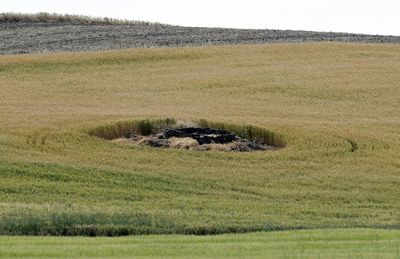Clear spot in field marks child’s grave

There is a field of barley a few miles outside Four Lakes along Granite Lake Road. In the distance, a field of winter wheat slopes up a hillside, interrupted only by a 50-foot spot of open space that has been left undisturbed for more than a century.
Crops have been planted all around but never over that particular piece of land. That open space is the gravesite of Minnie Maria Bassett, a little girl who drowned in a nearby spring in the summer of 1873. She was just a year-and-a-half old.
“It’s a good thing, preserving the grave,” said Jerry Johnson, who farms the surrounding land owned by his mother-in-law, Lorraine McMillan.
Minnie was born Jan. 2, 1872, in a cabin on the south side of the Spokane River near where the Post Street Bridge now stands in downtown Spokane. Historical accounts state that she was the first white child born “at Spokane Falls, Washington Territory.” She was the daughter of Wilbur Fisk Bassett, a prospector, carpenter and millwright who discovered gold in the Clearwater district in Idaho near Orofino in 1860, helped build the first sawmill in Spokane, farmed in the Four Lakes-Cheney area and is credited with naming Granite, Silver and Clear lakes.
When Minnie was still a baby, the family moved to a cabin built by her father on the same hillside where she is buried. That cabin, destroyed by fire in about 1884, was about 100 yards from a spring which has been known as Bassett Spring since the family homesteaded there.
The spring, surrounded by a cluster of trees, is historically significant for two reasons. It was the site where Col. George Wright and 700 soldiers camped in 1858 the night before engaging a group of Coeur d’Alene, Palouse and Spokane Indians in what was known as the Battle of Four Lakes. It is also the spring where Minnie drowned.
Herman S. Bassett, Minnie’s older brother, lived into old age and was the publisher of the Harrington Citizen for 52 years. In 1953, local historian and school teacher E.T. Becher wrote a history of the Bassett family, largely based on interviews with Herman Bassett, in The Spokesman-Review. In the account, Bassett remembers his sister’s death:
“The soil had not been broken, and the native unplowed ground toward the spring constituted a virtual flower garden at that time of year. Minnie loved to pick these flowers, and to play amongst them … (when Minnie couldn’t be found) the search finally led to the spring, the child was found floating on the surface, together with a considerable number of flowers which she had been holding in her hand before she fell in. It is thought that Minnie got into trouble either by noticing her reflection in the water, or that she was attempting to put the flowers in water, when she tripped and fell in.”
Bassett noted that their father carved Minnie’s initials into a headstone he fashioned from a piece of granite retrieved from nearby Granite Lake. That marker still stands above the grave.
Becher – author of “Spokane Corona, Eras & Empires,” which chronicles development of the region – taught at Rogers High School in Spokane. In 1956 his history class constructed a 3-foot rock wall encircling the grave site to protect and help preserve it for the future. A newspaper account notes that the students had to carry in sand, cement and water for the job and that they placed a bronze tablet at the site commemorating Minnie.
“To the consideration given to Minnie Maria’s grave … by each succeeding owner of the land, much has been done to preserve this spot for its historical significance, and we appreciate it,” Herman Bassett was quoted as saying.
Looking up at the grave from his fields today, farmer Jerry Johnson said that sometimes people interested in regional history stop by and ask about the grave. He and his wife Judy McMillan don’t mind.
And sometimes they take people up there. But only after harvest.